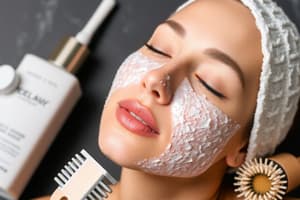Podcast
Questions and Answers
Which of the following ingredients commonly found in facial masks are known for their antioxidant properties?
Which of the following ingredients commonly found in facial masks are known for their antioxidant properties?
- Diatomaceous Earth and Calcium
- Vitamin A, C, and E (correct)
- Kaolin and Bentonite
- Honey and Glycerin
What is the primary function of desincrustation in facial treatments?
What is the primary function of desincrustation in facial treatments?
- To increase cell turnover and improve skin texture.
- To facilitate the extraction of milia.
- To stimulate circulation and oxygenate the skin.
- To deeply cleanse the skin and soften sebum for easier extractions. (correct)
When performing extractions of milia, what is the recommended technique after creating an opening in the skin?
When performing extractions of milia, what is the recommended technique after creating an opening in the skin?
- Apply high frequency to cauterize the opening and prevent infection.
- Apply firm, direct pressure to the center of the milium.
- Use a comedone extractor to forcefully remove the entire milium in one motion.
- Gently press and lift on the milia, applying more pressure on the 'unopened' side if needed. (correct)
Which of the following is a contraindication for using high frequency?
Which of the following is a contraindication for using high frequency?
An esthetician is considering massage techniques for a client. Which of the following conditions would be a contraindication for facial massage?
An esthetician is considering massage techniques for a client. Which of the following conditions would be a contraindication for facial massage?
Flashcards
Desquamation
Desquamation
The process of shedding the outer layer of skin, the stratum corneum.
Exfoliation
Exfoliation
The method of removing dead skin cells to enhance cell turnover and circulation.
High Frequency
High Frequency
A treatment technique that stimulates circulation without chemical changes.
Ultrasound Technology
Ultrasound Technology
Signup and view all the flashcards
Facial Massage Contraindications
Facial Massage Contraindications
Signup and view all the flashcards
Study Notes
Desquamation
- Stratum corneum
- New cells replace lower stratum cells; cell turnover is influenced by lifestyle, age, and health.
Exfoliation
- Increases cell turnover, blood flow, and circulation.
Beneficial Ingredients in Masks
- Vitamins A, C, E
- Hyaluronic acid
- Seaweed
- Calcium
- Diatomaceous earth
- Bentonite
- Kaolin
- Honey
- Glycerin
- Zinc oxide
Types of Masks
- Wax (setting/modeling)
Desincrustation
- Sit on face 10-15 minutes
- Galvanic current (for oily skin, not acne)
Extractions of Milia
- Spread skin tight around milia with fingertips
- Use sterile lancet to lift layers of cells
- Gently press and lift milia
- More pressure on the opposing side could help
High Frequency
- No polarity, doesn't produce chemical changes, but penetrates physically
- Effects: stimulates circulation, helps oxygenate the skin, increases cell metabolism
Contraindications (page 2)
- Inflammation
- Heart Problems
- Braces
- Body piercings (above waist)
Indirect High Frequency Technique (page 2)
- Regenerates the surface
- Increases blood flow
- Improves firmness and tones skin
- Suitable for dry skin
Facial Massage Contraindications (page 2)
- Sensitive skin
- Skin disorders
- Severe, uncontrolled hypertension
- Uncontrolled diabetes
Alternative Massage Techniques (page 2)
- Acupressure
- Shiatsu
- Pressure point massage
- Aromatherapy
- Manual lymph drainage
Ultrasound Technology (page 2)
- Ultrasound/ultrasonic: frequencies above audible range
- Equipment uses high-frequency mechanical oscillations (spatula-like tool)
Ultrasound Contraindications (page 2)
- Heart conditions
- Pacemakers or electrical implants
- Advanced diabetes
- Cancerous lesions
Definitions (page 2)
- Subcutaneous layer: layer beneath the skin
- Adipose: connective tissue in the endocrine system
- Keratinocytes: primary epidermal cells
- Merkel cells: specialized cells beneath the epidermis
Stratum Corneum (page 3)
- Outermost layer of the epidermis
Stratum Lucidum (page 3)
- Smooth, translucent layer of epidermis
Stratum Granulosum (page 3)
- Layer of cells in the epidermis
Stratum Spinosum (page 3)
- Also called the prickle cell layer
Stratum Germinativum (page 3)
- Separated from dermis by basement membrane, attached by hemidesmosomes
Sun Damage (page 3)
- Premature aging (photoaging)
- Can lead to skin cancer
Seborrhea (page 3)
- Chronic, relapsing skin condition that affects areas with many oil glands
Wrinkles/Aging (page 3)
- Skin becomes thinner, drier, and less elastic
Poor Elasticity (page 3)
- Skin becomes saggy, crinkled, or leathery
Cysts (page 3)
- Closed sac-like structures anywhere in the body
Studying That Suits You
Use AI to generate personalized quizzes and flashcards to suit your learning preferences.





